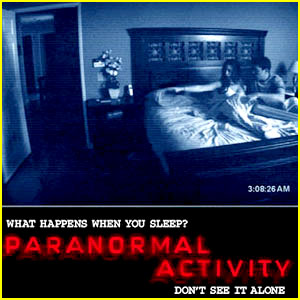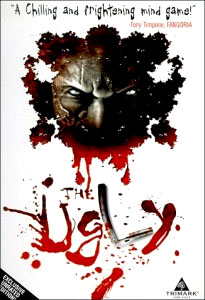Psychotherapy Horror Stories
It’s October and I’ve got Horror on my mind. Horror, as a genre, can be one of the most diverse and controversial storytelling styles for the simple fact that it is a pusher; a boundary pusher, a moré pusher, a comfort zone pusher. Horror exists on the other side of where we live. It’s part of the excitement.
Horror stories also have the unique ability, from this outside perspective, to comment on the common place aspects of our lives in compelling ways. Think of what Psycho did to the simple act of taking a shower. The horror story can be the magnifying glass or Carnival mirror view of the daily grind. It is from this perspective that I’d like to look at some of the common truths of therapy which take on sharper or greater focus, when put in the context of the horror story.
Paranormal Activity
“Don’t Uncover What You Can’t Recover.”
 I was so excited for Paranormal Activity and then it sucked so bad. Katie and Micah (Played by actors named Katie and Micah—isn’t that cute! They’re so beyond things like character names) move into a new home, and so does the ghost that’s “haunted Katie since she was a kid.” We later find out it’s a demon. Then we later find out that it’s connected to something that happened to Katie when she was a kid and is represented by a childhood photograph of her, which was thought to be lost in a fire.
I was so excited for Paranormal Activity and then it sucked so bad. Katie and Micah (Played by actors named Katie and Micah—isn’t that cute! They’re so beyond things like character names) move into a new home, and so does the ghost that’s “haunted Katie since she was a kid.” We later find out it’s a demon. Then we later find out that it’s connected to something that happened to Katie when she was a kid and is represented by a childhood photograph of her, which was thought to be lost in a fire.
Katie gets progressively worse throughout the movie; standing over Micah as he sleeps, staring into space and other creepily low budget things. There are minor overtures, mostly from Micah to attempt to figure out what happened to Katie but once the picture is found and then re-burned, Katie or the demon, amps up the paranormal activity and—no matter which ending you saw—the movie ends badly.
There is a clear current in all forms of therapy that self-discovery and processing of past events precedes healing. I agree. One must always undertake that process reverently, gently and with an eye on the clock and the calendar. I firmly believe that it is better to uncover only what you know you have the time to recover and look past sometimes glaring things that could still use processing, than to have your client vomit up all their hurtful moments and not have time for resolution. That’s just a way to create more trauma. Katie wasn’t ready for the minimal amount of self-rediscovery that she endured. Paranormal Activity may have no value beyond this analogy, and I’m fine with that: We all have demons in our attic. Don’t open the door if you don’t have time to close it.
Nightmare on Elm 3: The Dream Warriors
“It’s All About the Group.”
 I love group therapy. It’s no secret to those I work with. Group dynamics have a power that individual therapy—though equally crucial to healing—cannot match. In Nightmare on Elm Street, Nancy faced Freddy individually, and it became an instant classic. In Dream Warriors Nancy is the new staff member at Westin Hills psychiatric hospital. One of her roles is to assist Dr. Neil Gordon with his therapy group, a gathering of “the last of the Elm Street Children” who share the same vision of Freddy.
I love group therapy. It’s no secret to those I work with. Group dynamics have a power that individual therapy—though equally crucial to healing—cannot match. In Nightmare on Elm Street, Nancy faced Freddy individually, and it became an instant classic. In Dream Warriors Nancy is the new staff member at Westin Hills psychiatric hospital. One of her roles is to assist Dr. Neil Gordon with his therapy group, a gathering of “the last of the Elm Street Children” who share the same vision of Freddy.
There are some solid group therapy concepts nestled in this movie, which is equally as good as the first in the series. The seven Elm Street kids share a struggle which their staff member, Nancy has personal knowledge of. Not only is that a group therapy standard, it also fits into a recovery model. The therapist helps the kids develop their inherent strengths—okay, in this instance “Dream Powers”—to aid them in their struggle. They incorporate appropriate psychopharmacological aid, in the form of the fantasy drug Hypnocil.
Each character fulfills some standard group therapy roles: Kincaid, the tough guy who doesn’t need the group. Will, the people-pleasing “good kid.” Taryn, the one committed to staying negative. Jennifer, the drama queen. Joey, the quiet one. Kristen, the seeker. Philip, the one who’s negative consequences spur the group forward. Yes, most of these kids die.
Though extreme, that is also a fair depiction of group. Any grouping of people with issues is not simply designed to solve those issues because some of them are unsolvable and more importantly, people my not be committed to solving them. Will dies but takes a stand first. Kincaid survives with a new appreciation for connections with people, Kristen finds what she is seeking, and Joey discovers his voice is his strength. Four out of seven is not a bad success rate.
The Ring
“Family Therapy is for Everyone. Burying the Problem Feeds It.”

Wow, The Ring. Remember when it came out? I scoffed at a PG13 horror movie, but it was a crawly, insidious little jump-fest. Poor Samara and her family. Could therapy have helped Anna and Richard Morgan with Samara who was the identified patient? Well, I dunno how CBT works on the spawn of Satan, but it might have had better results that burying her in a well. The Morgans’ plight, though exaggerated, is a common one; the kid is the identified patient, but they become the identified problem. Family therapy needs participation from the whole family to be wholly successful. The kid who changes in treatment only to come back to the same family is a kid that will return to the same old behaviors, over and over, like a cycle…or a ring.
Hellbound: HellRaiser 2
“Maintain a Healthy Distance from Your Work”
 My other favorite horror series. In this sequel is also set in a psychiatric hospital, the Channard Institute, which Kirsty—our heroin—is admitted to following the events of Hellraiser. Class, Dr. Channard is the focus of today’s lesson. The man must have been a gifted psychiatrist at one point, after all he has a whole institute. But that institute, itself is a good model for the man. Above ground it was a creepily lit place of healing, but a place of healing none-the-less. Below ground it was a psychological house of horrors. Channard worked all day upstairs, then went downstairs to continue his pursuit of Hell through opening Lemarchand’s puzzle box and tinkering with the violently insane.
My other favorite horror series. In this sequel is also set in a psychiatric hospital, the Channard Institute, which Kirsty—our heroin—is admitted to following the events of Hellraiser. Class, Dr. Channard is the focus of today’s lesson. The man must have been a gifted psychiatrist at one point, after all he has a whole institute. But that institute, itself is a good model for the man. Above ground it was a creepily lit place of healing, but a place of healing none-the-less. Below ground it was a psychological house of horrors. Channard worked all day upstairs, then went downstairs to continue his pursuit of Hell through opening Lemarchand’s puzzle box and tinkering with the violently insane.
The moral of the story? Take breaks. Channard is a classic case of a therapist who let his personal life be swallowed by his professional pursuits and thus lost healthy perspective. For me, taking my notes, evaluations and treatment plan updates home instead of doing them at work is something that I always need to balance with having fun with my family, otherwise burnout will swallow all. Our clients and patients need that healthy perspective—in some cases it is exactly what they’re lacking to aid their own life. “What’s your pleasure, sir?” Little John asks at the end of the movie, just like the end of Hellrasier. That’s the question. What’s your pleasure and how do you ensure that you receive healthy doses of it to balance a truly challenging and draining vocation? Now, if you don’t balance your work I don’t expect that you’ll become a Cenobite who loves a skinless Hell-escapee, but it still begins to ruin your work and your life. Again, the moral: Avoid puzzle boxes and take breaks.
The Ugly
“Be Vigilant Against Transference.”
 “Wait? What’s The Ugly?” You ask. The Ugly is the movie that I saw a preview of on FearNet, but the movie wasn’t on FearNet. The Ugly is the first horror movie that I ever pursued, a decade after its 1997 New Zealand release. I was not disappointed. Well, I was with some of the acting, but the movie is sound.
“Wait? What’s The Ugly?” You ask. The Ugly is the movie that I saw a preview of on FearNet, but the movie wasn’t on FearNet. The Ugly is the first horror movie that I ever pursued, a decade after its 1997 New Zealand release. I was not disappointed. Well, I was with some of the acting, but the movie is sound.
Simon Cartwright is a killer who has been in a secure psychiatric hospital for years following his brutal murders. Dr. Karen Shoemaker is a young psychologist who believes Simon is cured of his delusional belief that inside him dwell otherworldly horrors who compelled his brutality. Psychiatrists would call them command auditory/visual hallucinations. Simon calls them The Ugly. Karen’s series of sessions just might have woke them up. Simon just might not be crazy. But Karen…
That’s the point of the movie. I guess Look Who’s Crazy would not have been as engaging a title, but it encapsulates the theme of transference; when a therapist begins to feel the emotions or adopt the beliefs of their patient. By essence, every one of these movie depictions is over-blown, but take the warning of Karen Shoemaker seriously. Transference happens, but it especially happens when you’re not watching and having supervision with a qualified professional. The most gifted trauma therapist can develop some PTSD symptoms after soaking up years of difficult stories and not wringing themselves out in a session to someone. Always talk to someone, always keep an eye on yourself—especially if you don’t think you need to. It’s good for you and good for your clients.
While horror is not for everyone, I believe that these theraputic truths are universal. I hope you’ve gained insight or support for your work with people, or at least for your Netflix que.


